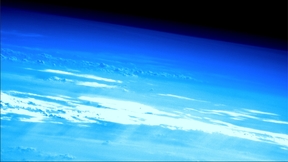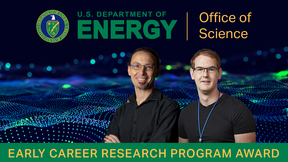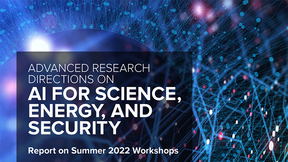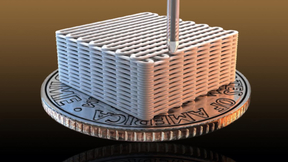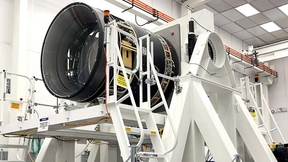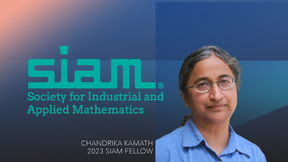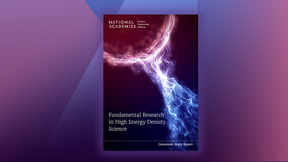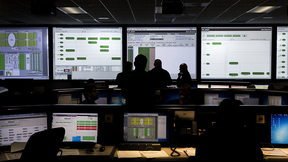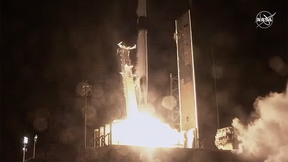Back
When SpaceX’s Dragon spacecraft docked with the International Space Station (ISS) on March 16, it delivered several thousand pounds of supplies for the crew as well as new hardware. The hardware included the U.S. Space Force’s Space Test Program Houston 9 (STP-H9) platform, which houses a prototype telescope designed and built by Lawrence Livermore National Laboratory's…
Two scientists from Lawrence Livermore National Laboratory (LLNL) are recipients of the Department of Energy’s (DOE) Office of Science Early Career Research Program award. Daniel Casey and Gauthier Deblonde are among 93 awardees receiving the recognition. Under the program, typical awards for DOE national laboratory staff are $500,000 per year for five years. “Supporting…
Innovations in artificial intelligence (AI) are rapidly shaping our world, from virtual assistants and chatbots to self-driving cars and automated manufacturing. Seizing on the potential of AI to transform science, the nation’s leading experts in science and technology have released a blueprint for the United States to accelerate progress by expanding its capabilities in…
The 44th Annual Telly Awards honored Lawrence Livermore National Laboratory (LLNL) with five awards for two videos that helped announce the Lab’s Dec. 5, 2022, fusion ignition achievement and visualize how experiments happen at the National Ignition Facility (NIF). LLNL’s Technical Information Department (TID) and the Office of Strategic Communications collaborated on the…
A Lawrence Livermore National Laboratory (LLNL)-developed technology known as Energy Inks has won a best in region award for the Far West region from the Federal Laboratory Consortium for Technology Transfer (FLC). This is the technology’s second award in the past nine months, as it received an R&D 100 award last September as one of the top 100 industrial inventions in…
A Lawrence Livermore National Laboratory (LLNL) engineer and the SLAC National Accelerator Laboratory are among those sharing a Department of Energy (DOE) award for their roles in building the world’s newest observatory. The DOE honor, the 2021 project management achievement award, was recently presented for work done on the Legacy Survey of Space and Time camera (LSSTCam)…
Four Lawrence Livermore National Laboratory (LLNL) postdoctoral appointees have been selected to attend the 72nd annual Lindau Nobel Laureate meeting in Germany this summer thanks to the University of California President’s 2023 Lindau Nobel Laureate Meetings Fellows Program. The four selected to attend are Wonjin Choi, Sean Leonard, Sijia Huang and Sarah Sandholtz. The…
A collective of regional business and civic leaders in the Tri-Valley has honored the Lawrence Livermore National Laboratory (LLNL) fusion ignition team for their “game-changing” breakthrough. The Innovation Tri-Valley (ITV) Leadership Group presented its 2023 #GameChangers Awards to eight innovative companies from the region in a ceremony on March 29 at Goal Line Studios…
Part 6 in a series of articles describing the elements of Lawrence Livermore National Laboratory's fusion breakthrough. For Lawrence Livermore National Laboratory (LLNL) physicist George Zimmerman, and for the hundreds of physicists, computer scientists and code developers who have worked on fusion for decades, computer simulations have been inexorably tied to the quest…
Lawrence Livermore National Laboratory (LLNL) staff scientists Alison Christopherson and Art Pak have been elected Kavli fellows of the U.S. National Academy of Sciences (NAS). As new Kavli fellows, they participated in NAS’ annual Kavli Frontiers of Science U.S. symposium, which brings together outstanding young scientists to discuss exciting advances and opportunities in…
Planetary defense physicist Megan Bruck Syal on Wednesday represented Lawrence Livermore National Laboratory (LLNL) at “Space STEM Task Force Pathways to the Federal Space Workforce,” an outreach event hosted by the National Science Foundation. Multiple federal government agencies came together in a virtual interactive session to provide information for students, early…
The Society for Industrial and Applied Mathematics (SIAM), the world’s premier professional organization for applied mathematicians and computational scientists, has selected Lawrence Livermore National Laboratory research staff member Chandrika Kamath as a member of the SIAM fellows class of 2023. The prestigious fellow designation is a lifetime honorific title and honors…
Part 5 in a series of articles describing the elements of Lawrence Livermore National Laboratory's fusion breakthrough. If Lawrence Livermore National Laboratory (LLNL)’s National Ignition Facility (NIF) were a race car, it would run at the redline most of the time. “NIF is the only laser system that intentionally operates above the laser damage growth threshold,” said…
Lawrence Livermore National Laboratory scientists have developed a theoretical model for more efficient molecular-level simulations of cell membranes and their lipid-protein interactions, part of a multi-institutional effort to better understand the behavior of cancer-causing membrane proteins. Developed under an ongoing collaboration by the Department of Energy (DOE) and…
Fourth in a series of articles describing the elements of Lawrence Livermore National Laboratory's fusion breakthrough. To achieve fusion ignition on Dec. 5, 2022, the National Ignition Facility (NIF)’s laser system needed to operate flawlessly at both ends of the performance spectrum, delivering immense energies while controlling the energy balance across all 192 laser…
The National Academies of Sciences, Engineering, and Medicine released a report, Fundamental Research in High Energy Density Science, which identifies key challenges and science questions for the field of High Energy Density (HED) science for the coming decade and proposes ways to address them. The report follows a year-and-a-half-long consensus study by a committee of 13…
In a room illuminated by blinking lights and glowing monitors, more than 2,000 synchronized computers are triggered to run 5 million lines of code. The intricate code language is responsible for aligning and firing 192 laser beams — and carrying some 800 channels of target diagnostic data — efficiently and reliably several times a day. This isn’t a scene from a science…
A prototype telescope designed and built by Lawrence Livermore National Laboratory (LLNL) researchers has been launched from Cape Canaveral, Fla., to the International Space Station (ISS). Known as the Stellar Occultation Hypertemporal Imaging Payload (SOHIP), the telescope uses LLNL patented-monolithic optics technology on a gimbal to observe and measure atmospheric…
When it comes to studying particles in motion, experimentalists have followed a 100-year-old theory that claims the microscopic motion of a particle is determined by random collisions with molecules of the surrounding medium, regardless of the macroscopic forces that drive that motion. Scientists at Lawrence Livermore National Laboratory (LLNL) and the Massachusetts…
Celebrating International Women’s Day on March 8, Lawrence Livermore National Laboratory (LLNL) women data scientists, Lab employees and other attendees interested in the field gathered at the Livermore Valley Open Campus for the annual Livermore Women in Data Science (WiDS) regional event held in conjunction with the global WiDS conference. Attendees met online and in…

